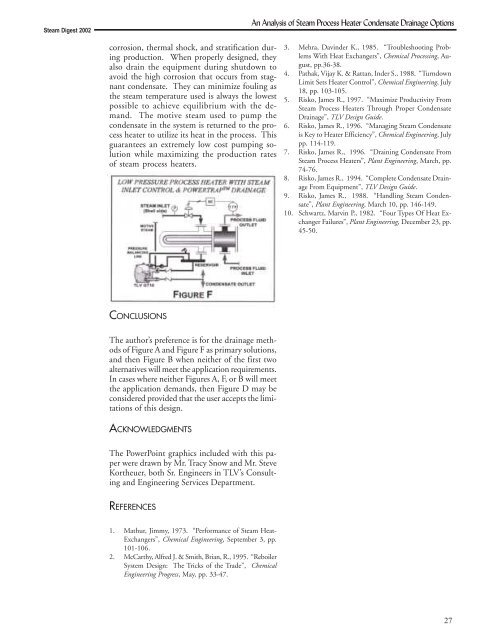Steam Digest 2002 - CiteSeerX
Steam Digest 2002 - CiteSeerX
Steam Digest 2002 - CiteSeerX
Create successful ePaper yourself
Turn your PDF publications into a flip-book with our unique Google optimized e-Paper software.
<strong>Steam</strong> <strong>Digest</strong> <strong>2002</strong><br />
corrosion, thermal shock, and stratification during<br />
production. When properly designed, they<br />
also drain the equipment during shutdown to<br />
avoid the high corrosion that occurs from stagnant<br />
condensate. They can minimize fouling as<br />
the steam temperature used is always the lowest<br />
possible to achieve equilibrium with the demand.<br />
The motive steam used to pump the<br />
condensate in the system is returned to the process<br />
heater to utilize its heat in the process. This<br />
guarantees an extremely low cost pumping solution<br />
while maximizing the production rates<br />
of steam process heaters.<br />
CONCLUSIONS<br />
The author’s preference is for the drainage methods<br />
of Figure A and Figure F as primary solutions,<br />
and then Figure B when neither of the first two<br />
alternatives will meet the application requirements.<br />
In cases where neither Figures A, F, or B will meet<br />
the application demands, then Figure D may be<br />
considered provided that the user accepts the limitations<br />
of this design.<br />
ACKNOWLEDGMENTS<br />
The PowerPoint graphics included with this paper<br />
were drawn by Mr. Tracy Snow and Mr. Steve<br />
Kortheuer, both Sr. Engineers in TLV’s Consulting<br />
and Engineering Services Department.<br />
REFERENCES<br />
1. Mathur, Jimmy, 1973. “Performance of <strong>Steam</strong> Heat-<br />
Exchangers”, Chemical Engineering, September 3, pp.<br />
101-106.<br />
2. McCarthy, Alfred J. & Smith, Brian, R., 1995. “Reboiler<br />
System Design: The Tricks of the Trade”, Chemical<br />
Engineering Progress, May, pp. 33-47.<br />
An Analysis of <strong>Steam</strong> Process Heater Condensate Drainage Options<br />
3. Mehra, Davinder K., 1985. “Troubleshooting Problems<br />
With Heat Exchangers”, Chemical Processing, August,<br />
pp.36-38.<br />
4. Pathak, Vijay K. & Rattan, Inder S., 1988. “Turndown<br />
Limit Sets Heater Control”, Chemical Engineering, July<br />
18, pp. 103-105.<br />
5. Risko, James R., 1997. “Maximize Productivity From<br />
<strong>Steam</strong> Process Heaters Through Proper Condensate<br />
Drainage”, TLV Design Guide.<br />
6. Risko, James R., 1996. “Managing <strong>Steam</strong> Condensate<br />
is Key to Heater Efficiency”, Chemical Engineering, July<br />
pp. 114-119.<br />
7. Risko, James R., 1996. “Draining Condensate From<br />
<strong>Steam</strong> Process Heaters”, Plant Engineering, March, pp.<br />
74-76.<br />
8. Risko, James R., 1994. “Complete Condensate Drainage<br />
From Equipment”, TLV Design Guide.<br />
9. Risko, James R., 1988. “Handling <strong>Steam</strong> Condensate”,<br />
Plant Engineering, March 10, pp. 146-149.<br />
10. Schwartz, Marvin P., 1982. “Four Types Of Heat Exchanger<br />
Failures”, Plant Engineering, December 23, pp.<br />
45-50.<br />
27
















